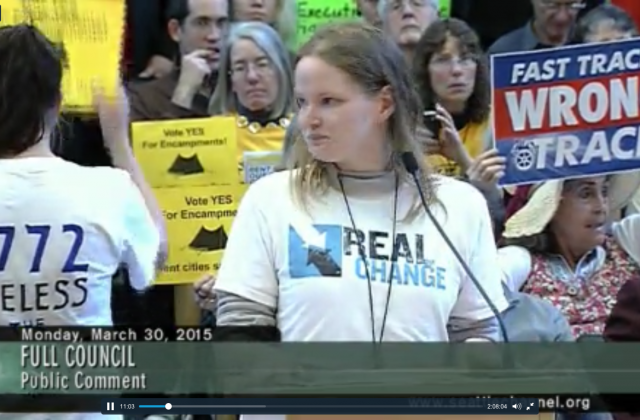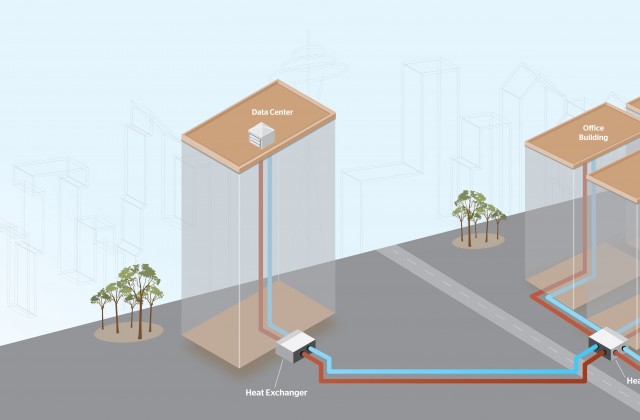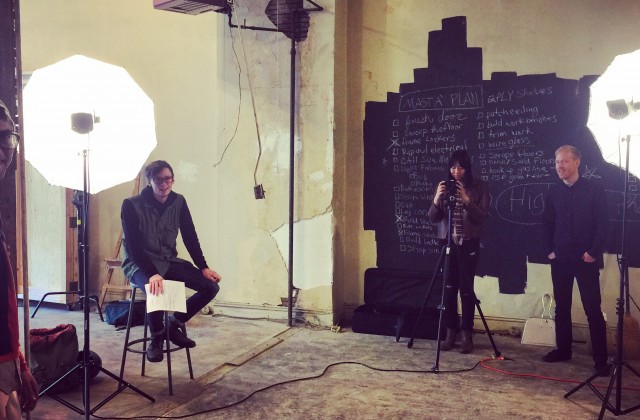Opening Up Single-Family Zones: “An Opportunity for a Decent Life”
The Seattle City Council actually did the right thing yesterday, passing Councilmember O’Brien’s legislation to permit encampments for people who are homeless and including an amendment by Councilmember Sawant to study encampments in single-family zones. We supported the legislation and the amendment, agreeing with Councilmember Sawant who said in yesterday’s discussion that:
We are all residents whether we have a roof over our head or not.
Very true. As we pointed out in our letter of support, why would we rule out any square inch of the city for new housing. But there is an irony here in what Councilmember Licata said:
We all have to look out for our fellow human beings in trying to give them a roof over their head an opportunity to have a decent life.
I wanted to add, “unless they are living in a new single-family home on a small-lot, or in microhousing, or an a building that is ‘out of character’ with the other houses on the block.”
I am glad the Council supported Councilmember Sawant’s efforts to study tent cities in single-family zones. In fact I sent a thank you note to all the Councilmembers:
Thank you for passing legislation to allow additional shelter options for people struggling with homelessness. And a special thanks for supporting Councilmember Sawant’s amendment to take a look at every neighborhood and part of our city for these kinds of permits and options. As you’ll remember from our attached letter, we supported Councilmember Sawant’s proposal.
I’d echo Councilmember Licata who said we should be supporting our “fellow human beings in trying to give them a roof over their head an opportunity to have a decent life.”
But this is true not only for people who want to find shelter in tent cities, but also for new people moving to our city who want to live on a small-lots in a single-family neighborhood in house that might not fit the “character” of the houses around it, in microhousing, or in other unique or dense housing options that are different than the prevailing single-family typology.
Please consider the same broad allowances for other types of housing like duplexes, triplexes, town homes, flex homes, cottage housing, and courtyard housing in single-family neighborhoods for the same reasons you passed this legislation: we need to provide housing opportunities for everyone who wants to live in our city, and single-family zones shouldn’t be off the table.
City Builder:Generating a Lot of Heat
Seattle is known for its fair share of eco-friendly solutions—green building, hydro-power, recycling, rain gardens, electric taxis, green roofs and composting come to mind. But McKinstry, always on the lookout to improve buildings’ systems efficiency, has implemented a new idea to solve an old problem by reusing the waste heat of a private colocation data facility to heat the offices of another corporation.
The Westin Building Exchange is the home to a large data center owned and managed by long-time McKinstry client Clise Properties. Data centers—the storehouses of row upon row of servers that make our daily lives possible—are notorious for expelling sirocco-like waves of heat. It’s a problem for the data centers because a lot of energy is needed to run these servers and a lot of energy and water is also needed to cool them off. This equates to a lose-lose situation for the environment, but a clear win for corporations and consumers who rely on the capacity of the data center for business as usual.
The heat generated by the Westin Building Exchange’s servers was not only going to waste, but also requiring the use of more energy to keep things cool. That’s where McKinstry and Clise started looking for ways to recycle the energy and heat that was being expelled by one system for use in another.
And then Amazon revealed plans to move across the street, and the stars aligned.
McKinstry has long been a proponent of reusing energy. It’s not only a part of their service offerings, they also walk the talk. In fact, the company’s local office reuses heat generated by their own data center to heat their onsite deli.
So where Clise connected the dots, McKinstry provided the solution; and together, the two companies created the 21st century version of an energy district between two high-rises in downtown Seattle—a first in itself.
Jeff Sloan, design manager and brains behind the technical solution, and Patrick Farley, head of McKinstry Capital who headed up the negotiations side of things, teamed up to arrive at the ultimate solution[SP3] . Here’s how it works: The heat put off by the data center is collected via the water in the cooling tower by a heat exchanger. It will then be piped underground to Amazon’s newest campus across the street to a heat recovery chiller and used to heat the building. Once the heat has been recovered, the water returns back underground to the Westin data center, where the process repeats ad infinitum.
It’s an all-around win. The Westin saves money in energy and water use, while Amazon saves about three-quarters on their utility bills for heating and gains an incentive from the utility companies. The utility companies, in turn, can sell the conserved energy and gas to other entities. And best of all, the environment takes less of a hit.
Looking at the bottom-line, developers, building owners and architects also comes out on top. From a Total Cost of Ownership standpoint, using the waste heat is more economically beneficial than other alternative solutions, and enables designers to take more creative liberties to incorporate modern design features and materials.
According to Sloan and Farley of McKinstry, data centers can now be energy resources and not just energy users. It’s a great example of private industry coming together with local government and innovating to forward the best interests of the community through environmental stewardship.
City Builder: Arts and Culture Always Part of a Great City
I had a chance today to talk with a local artist about space for art and culture. His project would bring a new gallery and work space for artists to a great downtown space. We agreed on one thing: Seattle needs to figure out how to grow, create more jobs, and build more housing while also making the city a place where art and culture can thrive. His point was that new development should pay for preserving space for art and culture, mine was that in many ways it already does. What’s obvious is that we need to do more.
Years ago I was an arts funder, and what I learned then was that the success of a city’s arts and cultural economy is deeply tied to real estate. I wrote an opinion piece for the Seattle Times back in 2007. Here’s what I said then:
The story follows a familiar path. A local arts organization without much money finds space in an older building where the rent is reasonable. The owner is willing to allow the group to knock out a couple of walls, make as much noise as it wants, and start doing what it does: art.
The owner isn’t interested at that time in selling the underutilized property for high rise-condos or other development, and the arts organizations, taking heart, sign or extend leases.
But, the day comes when the economic lure becomes too great, or family dynamics change, and the owner decides to sell. Faced with a changing use of the property, the arts tenants put out a call for help, but it’s too late.
Does it have to be this way?
The answer, of course, is no. I proposed some ideas back then I think are still good ones.
- Use the bonding capacity of the 4Culture public-development authority to acquire and redevelop key properties for cultural uses, which can generate enough revenue to pay back the bonds over time.
- Create incentive zoning that allows more building height in return for on-site cultural use or payment for it elsewhere. We can provide more housing, while sharing some of the profit for arts and culture.
- Expand the transfer of development rights for cultural use; the city could buy development rights from owners who have culturally significant properties and then resell that capacity for more housing somewhere else.
I’m not so sure about the “incentive” piece anymore after what I’ve seen the City do with that concept. Chances are it would end up just adding more costs. But an incentive program that offered reduced property tax for including long term use for non-profit arts organizations or individual artists might make sense.
In the end, a great city thrives because of innovation and collaboration, not fiats from City Hall or complicated schemes to hold up growth with taxes and fees.
The artist I spoke to today reminded me a lot of small builders contending with a myriad of rules and regulations from the City intended to solve lots of unrelated problems and adding costs. Someday, in his new space, I hope we can have a dialogue between builders and artists because I think we have a common interest in building a better city, and a common enemy: costly rules that make creating good things like art and housing more challenging.
Rasmussen Proposal More Protectionism than Conservation
Outgoing Councilmember Tom Rasmussen unveiled his concept called Neighborhood Conservation Districts, borrowed from other cities around the country and designed to preserve the difficult define concept of “neighborhood character.” Rasmussen justified doing this on his own (Rasmussen is chair of the transportation committee) by saying Councilmembers should be concerned about all issues affecting the city, even if it isn’t their area of responsibility on Council. Rasmussen did the same thing with microhousing two years ago, end-running land use chair at the time Richard Conlin, and more recently with Councilmember O’Brien on single family infill.
Oddly, though, Rasmussen told the 20 or so people as he introduced former Councilmember Peter Steinbrueck, “don’t blame me, this is Peter’s idea.” One wonders how much influence the former Councilmember has had over the proposal and Lund Consulting, a firm hired and paid for out of the Council’s discretionary consultant budget to staff the effort.
The problems with the idea of Neighborhood Conservation Districts are obvious to anyone who is familiar with the existing political environment in Seattle and how difficult and costly it already is to get a building permit. Seattle already has an expensive design review process that adds cost to housing. And design review is a process frequently devoted to explaining to neighbors that they can’t change underlying zoning. Who pays for all the process? Builders, who in turn have to pass that cost on to buyers and renters, which increases housing prices.
The consultant explained that a Neighborhood Conservation District would be defined by neighborhoods themselves, in particular the majority of property owners. An example? A neighborhood of post war bungalows would be protected from infill development that was too “modern in design and materials.” The approval process in a designated district would be governed by a board of neighbors that would preside over “changes to buildings.” Yes, that’s right, not just new construction but things like changes to doors, windows, rooflines, and even landscaping.
Councilmember Rasmussen actually has set aside money in this year’s budget to provide City staff for the boards should he get the proposal passed by the full Council, something he says he wants done and implemented by September this year.
What the proposal smacks of is government sanctioned Home Owner Associations (HOA), the bane of many a home or condominium owner because of HOA’s fussy and fastidious rules about everything from fixtures inside houses to how many Christmas lights are allowed. All this is sure to add to the costs not just of building new housing but to maintaining existing housing costs which, again, will get passed on to renters.
The consultant pointed out that the proposal was a way of protecting neighborhoods that are not historic or landmarked, but have “such a continuity that there is a story to tell here” and have buildings that are in “excellent condition, without any architectural changes.” Clearly the idea of the Neighborhood Conservation Districts is to do what you do when you “conserve” something by putting in a jar of formaldehyde: keeping it the same way forever.
And neighborhood comments and concerns from attendees made it pretty clear that they didn’t think the proposal went far enough. How to does this help deal with the fact that “single-family is disappearing and being replaced by high rises?” And more than one neighbor wondered, including former Councilmember Steinbrueck, what happens to single-family homes that are of “significance” that are in low-rise zones? How does the proposal preserve large houses in multifamily areas?
Not only that, a couple neighbors asked what about the “intangible elements” of character that are not captured by architectural standards. How, the neighbors wondered, can we preserve and control those? In the end the Rasmussen proposal is exactly pointing the wrong direction, attempting to stoke neighborhood desires to keep things the same when change is what Seattle needs to accommodate coming growth sustainably and affordably. Hopefully the proposal goes nowhere and disappears with Councilmember Rasmussen when finishes his term at the end of this year.
Micros and Housing: Smart Growth Seattle on the Dave Ross Show
Yesterday morning I had the chance to be on the Dave Ross Show on KIRO Radio. I think the interview was a great chance to get our message across about microhousing but also about the importance of housing affordability and choice in general. Give the segment a listen in the embed below.






